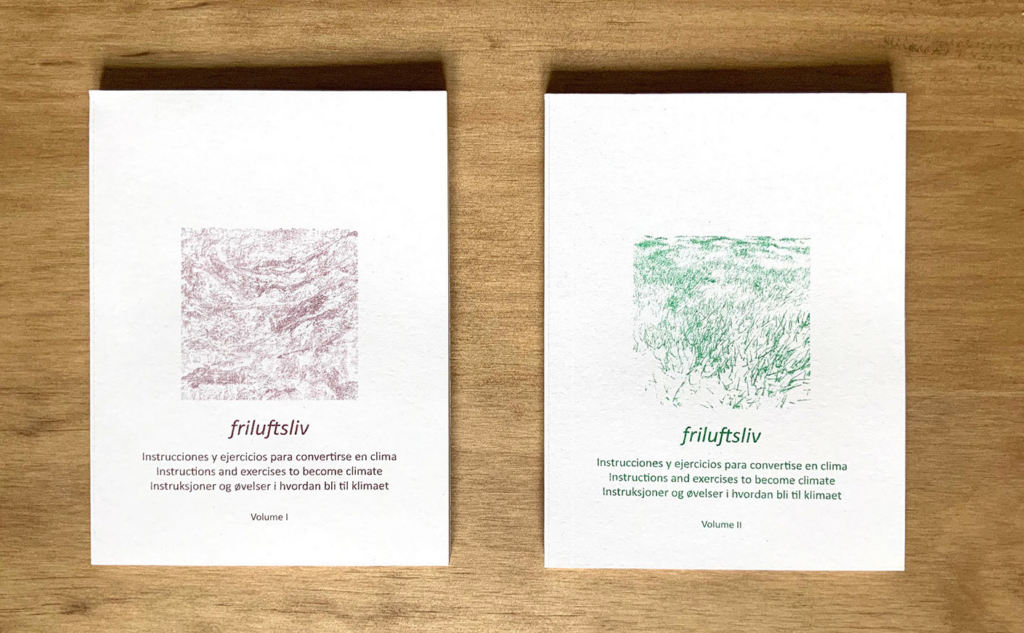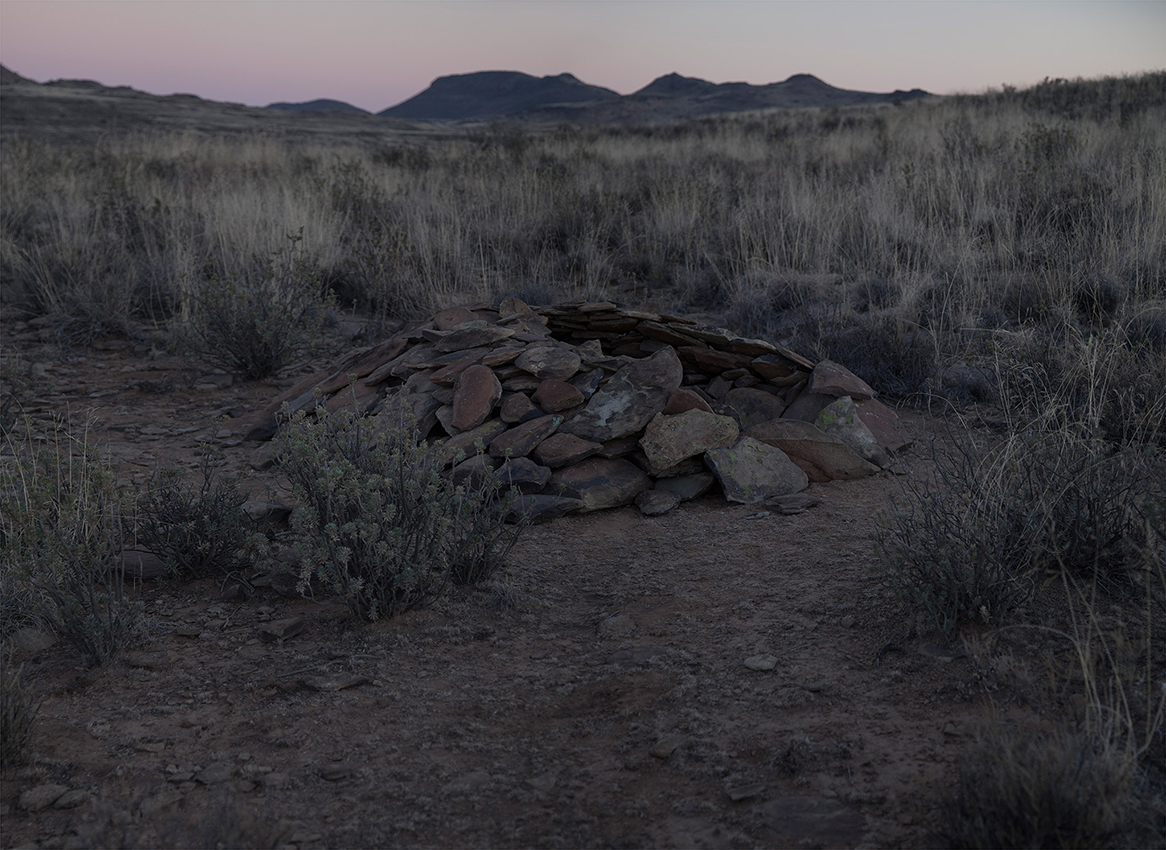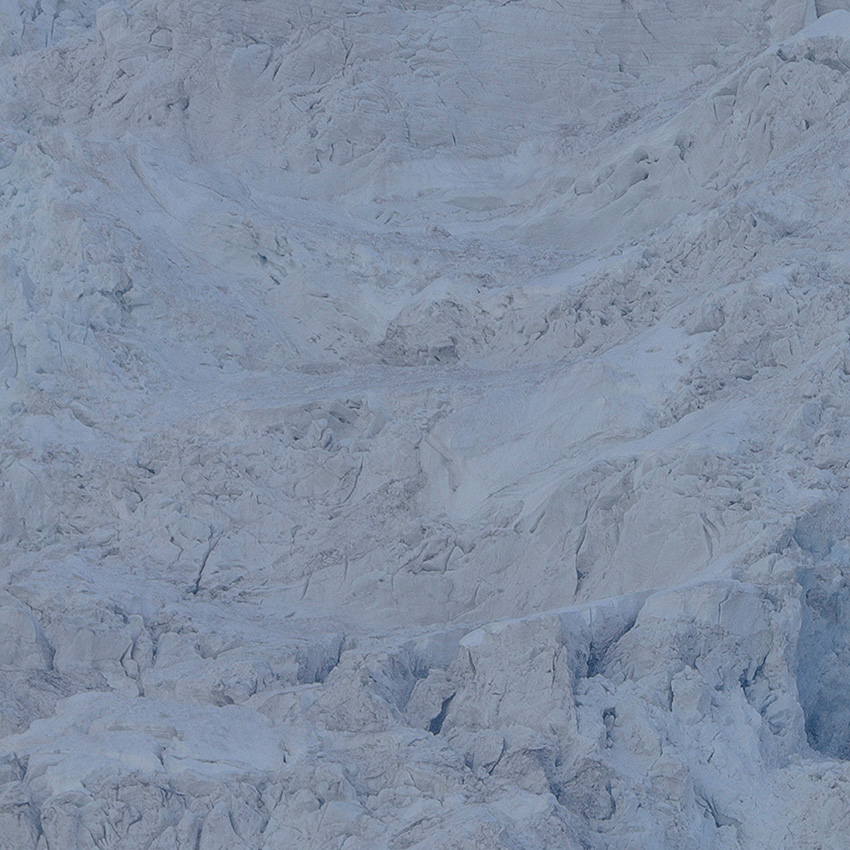Friluftsliv (o cómo convertirse en clima)
One-night-huts for friluftsliv. Color photography
One-night-huts for friluftsliv, building process. Color photography
In-walking. Color photography
T0. Color photography, audio and text. Installation view.
Becoming climate. Video HD, color.

Friluftsliv. Instrucciones y ejercicios para convertirse en clima. Libro-fanzine, dos volúmenes de 57 poemas. Impresión con risografía, hecho a mano, serie de 25. 9x14cm.
Descripción del proyecto
El proyecto Friluftsliv (o cómo convertirse en clima) consta de 5 series tanto de fotografías como videos, audios y textos y que se desarrolló principalmente en las montañas de un pueblo de Noruega, Leveld en hallingdal, pero que también se continuó en Sudáfrica.
Friluftsliv puede traducirse como “vida al aire libre” pero las connotaciones que implica son mucho más amplias que una simple traducción literal.
El filosofo Arne Naess lo describió como una filosofía de vida que explora y aprecia la naturaleza a través de la experiencia personal y simple y, esta visión, me sirvió como eje fundamental que define las estrategias del proyecto.
Parto de un modelo documental para confrontar la idea de cómo la naturaleza, y especialmente lo climático, nos transforma con cómo nuestras construcciones culturales condicionan nuestra propia experiencia.
Esto me lleva a cuestionarme cómo la experiencia personal se construye y se representa a través de la fotografía, para ello utilizo lo atmosférico, lo vulnerable, lo sutil y el tiempo lento como poética donde los recorridos en el territorio nos abren la puerta a recorridos personales.
Mi presencia en estos entornos de montaña me permite remarcar el carácter integrador y de pertenencia con el lugar a través de huellas y fragmentos de una vinculación táctil, física y emocional para proporcionar al espectador un espacio íntimo de reflexión sobre su propio posicionamiento.
One-night huts for friluftsliv
Esta serie se compone de 10 fotografías que documentan las cabañas que yo mismo construí para cobijarme durante una noche. Por la mañana salía durante varias horas caminando sin una dirección preestablecida ni fijada, y construía la cabaña con los materiales que me encontraba, dormía en ella, hacía la fotografía y a la mañana siguiente regresaba.
Lo impredecible y lo inesperado, la falta de imposición sobre que encontraré, dónde dormiré, y cómo construiré las cabañas, esa falta de control y dominio sobre la realidad sirven como catalizadores de una experiencia de vulnerabilidad.
In-walking
Una idea fundamental de Arne Naess es que uno “va dentro” de la naturaleza en lugar de “salir a” ella.
En esta idea de acercamiento-alejamiento, de esta dialéctica del interior-exterior, este conjunto de fotografías registran la experiencia del caminar a través de la huella, en la que el contexto queda abstraído y fragmentado evitando así la narración.
Para mí, el lenguaje fotografico tiene una incapacidad de abarcar la experiencia fenomenológica, en el momento en que la reduce a relato, siempre quedan huecos y es por eso que me interesa menos la fotografía como aquel lugar que nos muestra y más como la propia experiencia con la fotografía, la que posibilita un caminar interno
T0
Esta obra compuesta por 3 piezas de ámbitos lingüísticos diferentes -el visual, el sonoro y el textual- se sirven del recorrido desde Ustaoset a Tvergastein.
Tvergastein (piedras que se entrecruzan) es el nombre que el filósofo noruego Arne Naess dio a su cabaña en Hallingskarvet, montaña a la que adoptó como padre.
Considerado como el principal precursor de la ecología profunda, elaboró allí la mayor parte de su Ecosofia T.
La T se refiere también al término noruego que significa interpretación (tolkning). La T es especialmente valiosa por su naturaleza personal, por la idea de auto-realización a través de la percepción ampliada y expandida en la identificación con lo no humano.
Rechaza la idea de humano-en-el-ambiente en favor de una imagen relacional de humano-con-el-ambiente, de que “todo cuelga junto” pero insistiendo en que el individuo no se pierde ni se disuelve nunca en ese proceso de identificación.
Esta relación íntima e intensa con la montaña le lleva a evitar hacer distinción entre la cabaña, la vegetación y él mismo llegando a ser innecesaria, para él, la noción de medio ambiente.
Se podría condensar la esencia de su filosofía de vida, con base en las intuiciones-acercamiento fenomenológico que aprendió de-desarrolló en la cabaña-montaña como cuestionamiento profundo, experiencia profunda y compromiso profundo.
Becoming climate
Los videos de esta serie surgen de estar en paisaje, en un tiempo lento en el que se acepta lo que sucede.
En ellos, la luz, el viento, la niebla o la nieve se revelan a sí mismos acariciando el paisaje, una experiencia contemplativa sutil, elegante y delicada.
Friluftsliv. Instrucciones y ejercicios para convertirse en clima
Este libro-fanzine consta de dos volúmenes de 57 poemas cada uno con la idea de que pueda ser llevado siempre encima en el bolsillo para su consulta y práctica.
Está pensado a modo de instrucciones y ejercicios que se sitúan entre lo imposible y la más absoluta sencillez, rozando a veces lo banal, lo absurdo, lo insólito y el juego.
Project description
The project Friluftsliv (or how to become climate) is made up of five different series, consisting of photographs as well as videos, audios and texts, and was mainly done in the mountains of Leveld, a village in Hallingdal, Norway, but it was also expanded on somewhat in South Africa.
Friluftsliv can be translated as “free-air-life” but the connotations that it implies are wider than a simple literal translation.
Arne Næss described it as a philosophy of life that explores nature and appreciates it through direct experience in a personal and simple way, and this vision is used as the core idea that define the project’s strategies.
Starting from a documentary model I was interested in confronting the idea of how nature –and especially the climatic- transform us and how cultural thoughts condition the experience.
This lead me to think about how experience is built and represented through photography, using the atmospheric, the vulnerable, the subtle and the slowing of time as metaphor, where the routes of the territory open the door to personal paths.
My presence in those mountains allowed me to highlight the bond with the land. Through showing traces and fragments of a tactile, physical, and emotional connection I tried to provide the spectators with an intimate space to reflect on their own relationship with nature.
One-night-huts for friluftsliv
This series consists of ten photographs documenting the huts I built to shelter myself for one night. I walked early in the morning for several hours without a pre-determined direction. I built the huts with the materials I found, slept in them, took the pictures and left the next morning.
The unpredictable and the unexpected, the lack of imposition about what I would find, where I would sleep and how I would build the huts, that lack of control and domination over reality all work as catalysts for an experience of vulnerability.
In-walking
One essential idea of Arne Næss’ is that you go inside of nature rather than go out to it.
In this idea of approaching-distancing, in this dialectic of inside-outside, these photographs capture the experience of walking, through the traces where context is abstracted and fragmented, avoiding any narration.
T0
Conformed by 3 pieces of different linguistic fields –photography, sound and text- is based on the itinerary from Ustaoset to Tvergastein.
Tvergastein (crossed stones) is the name the Norwegian philosopher Arne Næss gave to his cabin in Hallingskarvet, a mountain he came to regard as an adoptive father.
In these mountains he developed most of his Ecosophy T philosophy, considered to be the main precursor of the deep ecology philosophy.
The letter T refers to the Norwegian word tolkning, which can be translated to mean interpretation.
The T is especially valuable because of its personal nature, for the idea of achieving self-realization through an extended and expanded identification with the non-human.
He rejected the idea of human-in-the-environment in favor of the more linked image of human-with-the-environment, an idea that “everything hangs together” while still insisting that the individual refrains from losing his own identity in the process.
This intense and intimate relationship with the mountain lead him to discard the notion that there were differences between cabin, vegetation, himself and environment.
The essence of his philosophy could, based on a phenomenological approach/intuition he learned/developed in the cabin/mountain, be condensed to deep questioning, deep experience and deep commitment.
Becoming climate
The videos of this series emerged from my being in the landscape, experiencing a slowing of time, where what happened was simply accepted.
The movement of light, wind, fog and snow are shown caressing the landscape in a subtle, elegant, delicate manner, encouraging a contemplative experience.
Friluftsliv. Instructins and exercises to become climate
This book-fanzine consists of two volumes of 57 poems each that can always be carried inside of a pocket to be looked at and practiced.
It is intended as instructions and exercises bordering between the impossible and absolute simplicity, at times moving between the banal, the absurd, the unbelievable and the playful.




























